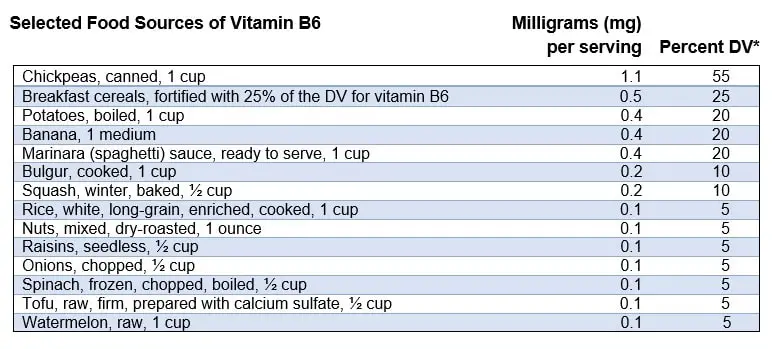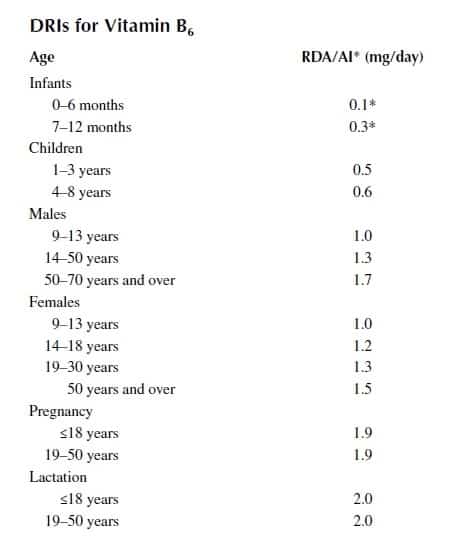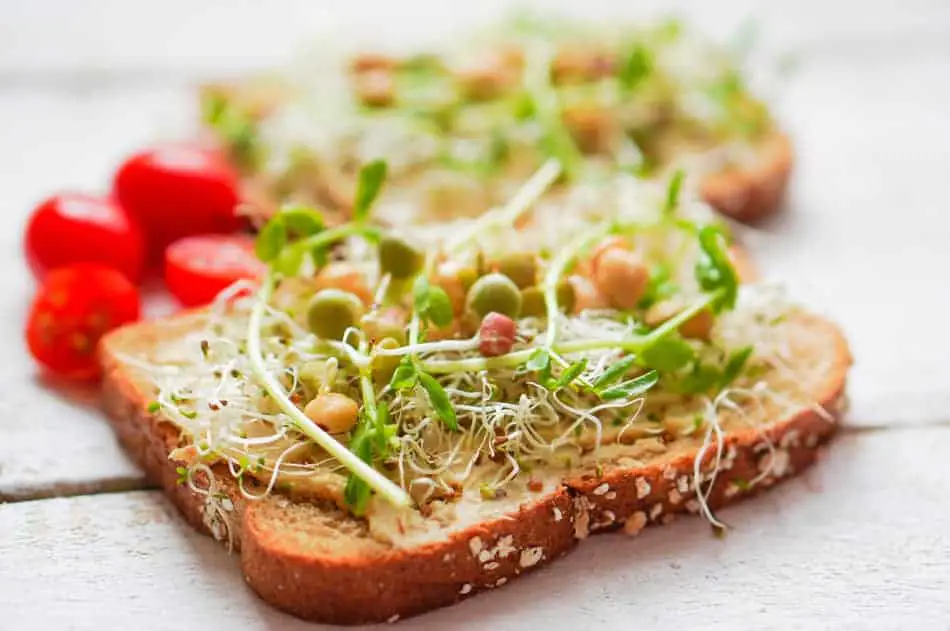What we’ll do here is cover some basic information about vitamin B6 or pyridoxine as relates to plant-based eating.
First, I’ll answer some common questions for those of you who are in a rush:
- Is vitamin B6 (pyridoxine) vegan? Yes, unlike vitamin D (check out the article here) and vitamin B12, vitamin B6 is found in numerous plant foods. As for supplements, B6 can be derived from animals but tends to be produced via chemical synthesis.23 So, it’s typically considered vegan.
- What are some vegan sources of vitamin B6? Plant-based foods that are rich sources of B6 include chickpeas, whole-grains/whole-grain products, certain fruits and vegetables (e.g. bananas, squash), nuts, and fortified cereals.1 (See the chart below for more examples)
- Are vegans commonly deficient in vitamin B6? No, not characteristically. According to NIH, those at risk for B6 deficiency include individuals with impaired renal function, autoimmune disorders, and alcohol dependence.
Next, let’s take a closer look at the sources of B6 as well as some other basic info.
Overview and Functions
In 1934, Paul György, a Hungarian physician, discovered a substance that was able to correct dermatitis in rats. György named the substance vitamin B6.2,3
Later on 1939, Harris and Folkers determined the structure of pyridoxine, and, a bit later in 1945, Snell was able to show that there were two forms of B6, pyridoxamine and pyridoxal.
To clear up
The vitamers are interchangeable and similarly active.
As for vitamin B6, it exists as six different vitamers:
- Pyridoxine (the alcohol form)
- Pyridoxal (the aldehyde form)
- Pyridoxamine (the amine form)
- Pyridoxine phosphate (PNP)
- Pyridoxal phosphate (PLP)
- Pyridoxamine phosphate (PMP)
As you can see, the latter three are the same, but with a phosphate (5′-phosphate derivative). They’re the coenzyme forms of the vitamin that carry out a number of important functions.
For example, the PLP variant is associated with over 100 enzymes, most of which are involved in the metabolism of amino acids.4
The noncoenzyme role of vitamin B6 involves it’s effects on gene expression.
Coenzyme Roles
Amino Acid Metabolism
AA Catabolism and Synthesis of Non-Essential AAs
You may have wondered why out of 20 amino acids, only 9 are essential—that is, only 9 are needed from the diet. The reason for this is that your body can make the other 11 by the processes known as transamination and deamination.
Transamination and deamination reactions are important as they are responsible for synthesizing nonessential amino acids. They’re also essential for turning amino acids into energy and glucose.
Vitamin B6 in the forms of PLP and PMP are involved in transamination as coenzymes for aminotransferases—an enzyme that transfers the amino group (−NH2) from one AA to an α-ketoacid.
If you’ve ever gotten blood work done that involved liver enzymes, then you may be aware of AST and ALT. Well, the specific aminotransferases for which PLP and PMP are coenzymes include:
- Aspartic amino transferase (AST, aka glutamate oxaloacetate transaminase or GOT)
- Alanine aminotransferase (ALT, aka glutamate pyruvate transaminase or GPT)
PLP takes part in many reactions that remove amino groups from (among other compounds) releasing them as ammonia or an ammonium ion.
Neurotransmitter Synthesis
PLP is also utilized in a certain type of reaction known as decarboxylation. These reactions involve the removal of the carboxy (COO−) group from the AA.
In doing so, PLP takes part in:
- GABA formation from glutamate
- Serotonin synthesis from 5-hydroxytryptophan
- Histamine synthesis from the amino acid histidine.
- Processing the AAs phenylalanine and tyrosine so they can go on to form dopamine.
Homocysteine Metabolism
PLP is needed for two enzymes that catalyze reactions in the pathway by which cysteine is synthesized from methionine. The enzymes include cystathionine synthase and cystathionine lyase.
Glycine Formation
We won’t get into the details, but PLP catalyzess cleavage reactions so that serine is ultimately used to make glycine.
Heme Synthesis
Vitamin B6 is needed as a coenzyme for the first step in the synthesis of heme. As we’ll see, defects in heme synthesis are apparent in B6 deficiency which manifests as microcytic anemia.
Other Select Synthetic Reactions Using PLP
- PLP serves as a cofactor for sphingolipid synthesis
- PUFA synthesis—in fatty acid metabolism, PLP is used to synthesize certain polyunsaturated fats
- Niacin synthesis—as we saw in the previous article on B3, niacin can be made from tryptophan. There’s an important PLP-dependent reaction that is used to make niacin from tryptophan.
- Carnitine synthesis—a nitrogen-containing compound needed for fatty acid oxidation
- Taurine synthesis—a neuromodulator made by cysteine metabolism
Glycogen Degradation
Glycogen is stored in the muscle, and most vitamin B6 present in muscle is in the form of PLP, which is bound to glycogen phosphorylase. This particular role is thought to account for more than 50% of the body’s vitamin B6 usage.
Both plants and animals store carbohydrates—plants in the form of starch, and humans in the form of glycogen. Well, when it comes time to break glycogen out of storage to use for energy, PLP is needed in order to degrade the glycogen.
It’s actual function in this process is poorly understood, but it’s thought that vitamin B6 is required for the activity of glycogen phosphorylase.
Noncoenzyme Role: Modulation of Gene Expression
While the non-coenzyme roles haven’t been nearly as thoroughly investigated as the coenzyme functions, it seems that B6 may be involved in gene expression. It’s been shown to bind to DNA and to modulate the binding of steroid hormone or transcription factors to the regulatory regions on DNA.5
Vegan Sources of Vitamin B6
All six vitamin B6 vitamers can be found in food. The most stable of the compounds, pyridoxine (and its phosphorylated form) are found nearly exclusively in plant foods. Sometimes, in plants, vitamin B6 occurs as pyridoxineglucoside (a conjugated form).
In contrast, pyridoxamine and pyridoxal (and their phosphorylated forms) are found mostly in animal products (steak, salmon, chicken, etc.)
- Whole-grain products. One slice of multi-grain bread contains 0.1 mg or 3%.6
- Fortified cereals. For example, 1 Cup of Cheerios® (not technically vegan) provides 0.5 mg or 25% of the Daily Value of 2 mg.7
- Fruits and vegetables. One large banana will provide you about 0.5 mg (25% DV). One cup of raw carrots provides 0.2 mg or 9% DV.8,9
- Nuts. 1 oz of pecans has 0.1 mg or 3% DV.10
- Supplementation. In supplement form, vitamin B6 is usually present as pyridoxine hydrochloride.
Select Vegan B6 Sources

Source: Office Of Dietary Supplements – Vitamin B6 https://ods.od.nih.gov/factsheets/VitaminB6-HealthProfessional/
The DV for B6 used in deriving the values on the above table is 2 mg for adults and children 4 years of age and older.11
This DV will be changing to 1.7 mg per the updated Nutrition and Supplement Facts labels.23
The updated labels aren’t required to appear on food products and dietary supplements until January 2020, but they can be used now.12
Vitamin B6 isn’t a nutrient that the FDA requires food labels to list unless a food product has been fortified with it. Foods that provide at least 20% DV are considered high sources of vitamin B6, but foods providing less than this amount also contribute to a healthy diet.
The U.S. Department of Agriculture’s (USDA’s) National Nutrient Database has a big list of foods and their nutrient content (including vitamin B6) arranged by food name and nutrient content.”13
Vegan Vitamin B6 Needs
Because bioavailability isn’t a problem with this nutrient, vegans have the same needs as the rest of the population.
Recommendations change in adulthood. For adult men, age 19 to 50 years, the recommendation is 1.3 mg/day and for men, 51 years and over, the recommendation rises to 1.7 mg per day.14
Recommendations for adult women are 1.3 mg/day for those 19 to 50 years, and for women age 51 years and over, they rise to 1.5 mg daily.14
As for pregnancy and lactation, B6 recommendations increase to 1.9 mg/day and 2.0 mg/day, respectively.14
These recommendations were based largely on maintenance of adequate blood levels of B6—at least 20 nmol/L.14
Some experts have suggested recommendations may need to be raised.15,16

Source: Micronutrients in Health and Disease. Kedar Prasad – Crc – 2011
Deficiency Symptoms
Because of it’s presence in a wide range of foods, vitamin B6 deficiency tends to be relatively rare in the US.
Interesting history tidbit – there was a time in the 1950s, when deficiency was somewhat common in infants due to heat treatment of infant milk.
Extreme heat treatment caused a reaction between PLP and the lysine content of the milk proteins forming
When B6 deficiency does occur, onset can happen as early as 2-3 weeks of inadequate intake, but can take up to 2 ½ months.
Symptoms of B6 deficiency include:17
- Weakness and fatigue
- Skin problems—seborrheic rash on the face, neck, shoulders, and buttocks areas.
- Like riboflavin and niacin, B6 deficiency can lead to inflammation of the mouth and oral cavity—cheilosis, glossitis (tongue) and angular stomatitis (corners of the mouth).
- Neurological problems from mild confusion to seizures, convulsions, and peripheral neuropathy.
- Hypochromic, microcytic anemia—as mentioned PLP is used in heme synthesis.
- Niacin deficiency—B6 is needed to make niacin from tryptophan.
- Hyperhomocysteinemia (a risk factor for CVD)—as mentioned above, B6 is needed in the metabolism of homocysteine.
The Vegan Diet and B6 Status
It’s complicated. While B6 status has been shown to be adequate, some studies have indicated that vegans do exhibit signs of deficiency.18
One study of 37 elderly women showed vegetarians to consume higher levels of many vitamins and minerals, however risk of B6 deficiency was noted.19
Overall, it’s not a huge area of concern. It would be prudent, however, to keep an eye on intakes.
As far as CVD risk, you’ll want to ensure adequate intake of vitamin B6 as well as folate and B12.
If you remember from above, hyperhomocysteinemia was listed as a potential complication of B6 deficiency due to the role the vitamin plays in homocysteine metabolism. Well, plasma concentrations of homocysteine are inversely connected to the intakes of folic acid, B12 and B6.20
This is because all three vitamins play a role in clearing homocysteine from the blood. Even if you manage to get sufficient intake of B6, homocysteine can still build up if one of the other two vitamins are deficient.
Vegetarians tend to have relatively high intakes of both folate and B6, compared with the general population.21Which is great. However, vegetarians (especially vegans) tend to have relatively low intakes of vitamin B12.22
So overall, watch your B vitamin intake. Ensure you’re eating plenty of the food sources listed in the B6 and folate articles. As for B12, get a good quality supplement.
References
- Office Of Dietary Supplements – Vitamin B6 https://ods.od.nih.gov/factsheets/VitaminB6-HealthProfessional/
- György, Paul (1934). “Vitamin B2 and the Pellagra-like Dermatitis in Rats”. Nature. 133 (3361): 498–9.
- György, Paul; Eckardt, Robert Edward (1940). “Further investigations on vitamin B6and related factors of the vitamin B2complex in rats. Parts I and II”. Biochemical Journal. 34 (8–9): 1143–54
- Gropper, Sareen S.; Smith, Jack L. Advanced Nutrition and Human Metabolism (Page 361).
- Oka T. Modulation of gene expression by vitamin B6. Nutr Res Rev. 2001; 14:257–65.
- Bread, Multi-grain, Toasted (includes Whole-grain) Nutrition Facts & Calories https://nutritiondata.self.com/facts/baked-products/4847/2
- Cereals Ready-to-eat, General Mills, Cheerios Nutrition Facts & Calories https://nutritiondata.self.com/facts/breakfast-cereals/1522/2
- Bananas, Raw Nutrition Facts & Calories https://nutritiondata.self.com/facts/fruits-and-fruit-juices/1846/2
- Carrots, Raw [includes Usda Commodity Food A099] Nutrition Facts & Calories https://nutritiondata.self.com/facts/vegetables-and-vegetable-products/2383/2
- Nuts, Pecans Nutrition Facts & Calories https://nutritiondata.self.com/facts/nut-and-seed-products/3129/2
- U.S. Food and Drug Administration. Guidance for Industry: A Food Labeling Guide external link disclaimer (14. Appendix F: Calculate the Percent Daily Value for the Appropriate Nutrients). 2013.
- U.S. Department of Agriculture, Agricultural Research Service. USDA National Nutrient Database for Standard Reference, Release 27. Nutrient Data Laboratory Home Page, 2014.
- Food and Nutrition Board. Dietary Reference Intakes for Thiamin, Riboflavin, Niacin, Vitamin B6, Folate, Vitamin B12, Pantothenic Acid, Biotin, and Choline. Washington, DC: National Academy Press. 1998 pp. 150–95.
- Kwak H, Hansen C, Leklem J, et al. Improved vitamin B-6 status is positively related to lymphocyte proliferation in young women consuming a controlled diet. J Nutr. 2002; 132:3308–13.
- Rogovik AL, Vohra S, Goldman RD. Safety considerations and potential interactions of vitamins: should vitamins be considered drugs? Ann Pharmacother. 2010; 44:311–24.
- Gropper, Sareen S.; Smith, Jack L. Advanced Nutrition and Human Metabolism (Page 364).
- Crane MG, Register UD, Lukens RH, Gregory R. “Cobalamin (CBL) studies on two total vegetarian (vegan) families” Vegetarian Nutrition 1998; 2(3):87-92.
- Nieman, D.C., Underwood, B.C., Sherman, K.M., Arabatzis, K., Barbosa, J.C., Johnson, M., and Shultz, T.D. Dietary status of Seventh-Day Adventist vegetarian and non-vegetarian elderly women. J. Am. Diet. Assoc., 89, 1763, 1989.
- Hankey, G.J. and Eikelboom, J.W. Homocysteine and vascular disease. Lancet, 354: 407, 1999.
- Draper, A., Lewis, J., Malhotra, N., and Wheeler, E. The energy and nutrient intakes of different types of vegetarian: a case for supplements? Brit. J. Nutr., 69: 3, 1993.
- Sanders, T.A.B. The nutritional adequacy of plant-based diets. Proc. Nutr. Soc., 58: 265, 1999.
- U.S. Food and Drug Administration. Food Labeling: Revision of the Nutrition and Supplement Facts Labels.external link disclaimer 2016.
- Jose L. Revuelta, Ruben M. Buey, Rodrigo Ledesma‐Amaro, and Erick J. Microbial biotechnology for the synthesis of (pro)vitamins, biopigments and antioxidants: challenges and opportunities. Microb Biotechnol. 2016 Sep; 9(5): 564–567.

